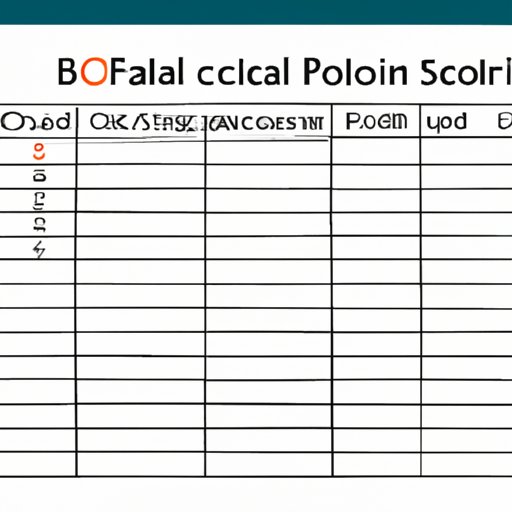How to Remove Blank Rows in Excel: A Step-by-Step Guide
As someone who’s worked with Excel before, you know how important it is to keep your spreadsheets clean and organized. One issue that can make this difficult is blank rows.
Blank rows can be frustrating, making it more difficult to read and understand your data. Fortunately, there are several ways to quickly remove these rows and get your spreadsheet back in order. In this article, we’ll go over the basics of removing blank rows in Excel using built-in tools, as well as alternative strategies, time-saving tips, common problems, and solutions. We’ll also provide before-and-after examples and a video tutorial.
Basic Steps for Removing Blank Rows in Excel
Excel comes with two tools that can help you quickly remove blank rows: the ‘Go To Special’ and ‘Filter’ functions.
To remove blank rows using the ‘Go To Special’ function, follow these steps:
- Select the area of the spreadsheet you want to clean up.
- Click ‘Ctrl+G’ to bring up the ‘Go To’ dialog box.
- Select ‘Special’.
- Select ‘Blanks’.
- Click ‘OK’.
- Right-click on one of the selected rows and click ‘Delete’.
- Choose ‘Entire Row’ and click ‘OK’.
To remove blank rows using the ‘Filter’ function, follow these steps:
- Select the column headers in your spreadsheet.
- Click the ‘Filter’ button on the ‘Data’ tab of the Ribbon.
- Find the column you want to filter (the column containing blank rows) and click on the filter drop-down arrow.
- Select ‘Blanks’.
- Select the rows with blanks.
- Right-click on one of the selected rows and click ‘Delete’.
- Choose ‘Entire Row’ and click ‘OK’.
- Click the ‘Filter’ button again to turn off the filter.
With these tools, removing blank rows should be a breeze. But what if you want to try other strategies?
Alternative Strategies for Removing Blank Rows in Excel
If you don’t want to use the built-in tools for removing blank rows, there are several alternative strategies:
1. VBA Macro: If you’re comfortable with VBA (Visual Basic for Applications), you can use a macro to remove blank rows. This method is helpful for automating the process when dealing with large spreadsheets.
2. Sort by Specific Column: You can also sort your data by a specific column to group all the blank rows together. Then, you can select them and delete them all in one go. This is especially useful if you have a lot of columns in your spreadsheet.
3. Formula Function: Using Excel’s formula function, you can create a helper column that tells you which rows are blank. You can then filter by that column to delete the blank rows.
Each strategy has its own pros and cons. The ‘Sort by Specific Column’ method is the easiest method, but you may lose the original order of your data. Meanwhile, using a VBA Macro can be more time-consuming and complicated, but it’s the most efficient method if you’re dealing with many blank rows.
If you’re interested in trying these alternative strategies, here are detailed instructions:
VBA Macro:
- Open an Excel file, and press ALT + F11 to open VBA Editor.
- Select the module where you want to insert the code (or create a new one).
- Copy and paste the following code:
- Press F5 or click on the ‘Run’ button to execute the macro.
Sub DeleteBlankRows()
'Delete all rows that are completely empty from the active sheet
On Error Resume Next
With ActiveSheet
.Range("A:IV", .Cells(.Rows.Count, "A")).SpecialCells(xlCellTypeBlanks).EntireRow.Delete
End With
End Sub
Sort by Specific Column:
- Select the range that includes the blank rows.
- Click ‘Data’ on the Ribbon and select ‘Sort’.
- Select the column by which you want to sort your data.
- Choose either ‘Ascending’ or ‘Descending’ order for the sort.
- Click ‘OK’ to apply the sort.
- Select the now-grouped blank rows.
- Right-click on one of the selected rows and click ‘Delete’.
- Choose ‘Entire Row’ and click ‘OK’.
Formula Function:
- Create a blank column next to the column with the data you want to test for blanks.
- In the first cell of your new blank column, enter the following formula (assuming your data is in column A):
- Double-click the fill handle to copy the formula down to all rows.
- Select the column header of the helper column you just created, click ‘Data’, and then click ‘Filter’.
- Select ‘TRUE’ from the filter dropdown, which will show you only the rows with blanks.
- Select the rows with blanks.
- Right-click on one of the selected rows and click ‘Delete’.
- Choose ‘Entire Row’ and click ‘OK’.
- Remove the helper column by selecting the column header and pressing the ‘Delete’ key.
=IF(ISBLANK(A2),TRUE,FALSE)
Before-and-After Examples of Removing Blank Rows in Excel
Before you start removing blank rows, it can be hard to imagine what a difference it will make. That’s why we’ve put together a visual example of how much more organized a spreadsheet can look after blank rows have been removed.

As you can see, even a small amount of blank rows can make a big difference in how readable your spreadsheet is.
Time-Saving Tips for Removing Blank Rows in Excel
To save even more time when removing blank rows, there are several keyboard shortcuts and tricks you can use.
1. Press ‘Ctrl+Shift+Down Arrow’ to select all the rows from the active cell to the last cell of the used range. This will save you time if you have a lot of blank rows.
2. Use ‘Ctrl+H’ to bring up the Find and Replace dialog. You can then find all the blank cells and replace them with a value that you can easily filter, like a hyphen (-).
Common Problems and Solutions When Removing Blank Rows in Excel
Although removing blank rows in Excel is usually straightforward, there are some common issues you may encounter:
1. Merged Cells: Blank merged cells may not be removed by the ‘Go To Special’ or ‘Filter’ functions. To fix this, you’ll need to unmerge the cells, select the blank rows, and then merge them again.
2. Hidden Rows: The ‘Go To Special’ function will not select blank rows that are hidden. To solve this, unhide the hidden rows before removing the blank rows.
Video Tutorial for Removing Blank Rows in Excel
If you’re more of a visual learner, we’ve put together a video tutorial that shows you how to remove blank rows in Excel step-by-step. This tutorial will cover the two built-in Excel tools – the ‘Go To Special’ and ‘Filter’ functions – and provide some time-saving tips along the way:
Conclusion
Removing blank rows in Excel is an important part of keeping your spreadsheet organized and readable. Whether you use the built-in tools or alternative strategies like VBA macros or formula functions, removing blank rows should be a straightforward process. Just remember to watch out for common issues like merged cells and hidden rows, and use time-saving tips like keyboard shortcuts and tricks.
